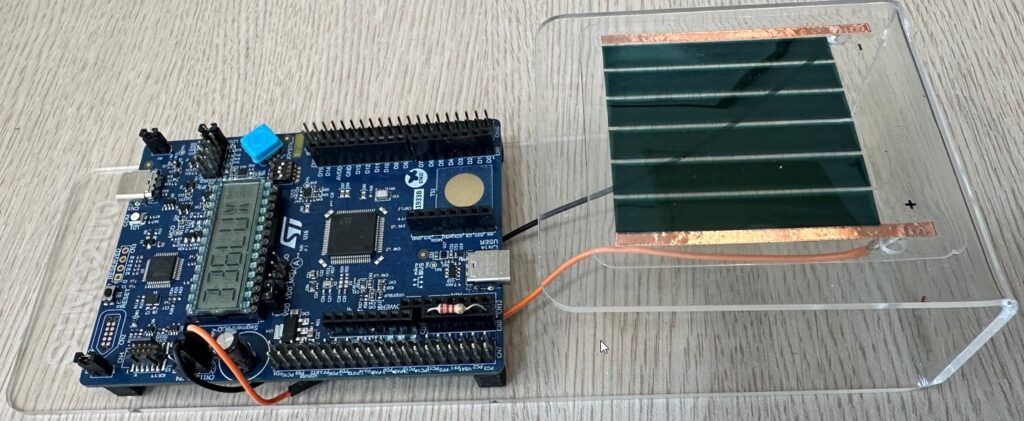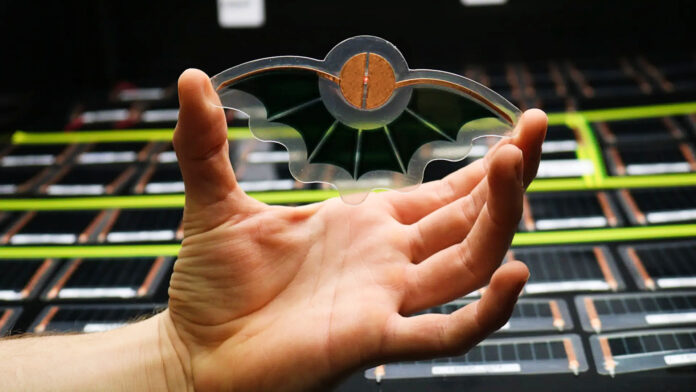Embedded World 2024, Nuremberg: Chip manufacturer STMicroelectronics (STMicro) is working with ambient IoT startup Dracula Technologies to use its energy-harvesting organic photovoltaic (OPV) technology in its new STM32U0 line of microcontrollers (MCUs). The two French firms are showing Dracula’s LAYER OPV product on the STM32U0 MCU at Embedded World this week. Dracula has joined STMicro’s ‘partner program’ to formalise the partnership.
As trailed in these pages through the back-end of 2023, Dracula has already developed a prototype tracker that runs on its LAYER OPV cell – which can be printed in any size, depending on the power output, onto an 0.3mm adhesive sticker on a regular inkjet printer using special OPV ink. For marketing purposes, it is presented as a bat-shaped photovoltaic printout (see image) that works at 200 lux, and even down to 100 lux. It is pitching the solution for cheap and battery-free low-power IoT.
The OPV unit – which uses a reference LoRaWAN module from Semtech and a cloud stack from TTI – works in low light in dark rooms. It draws power in the murkiest conditions, such as in warehouses or factories, where the luminous flux per unit area (lux), which measures illuminance, goes as low as 500. (Outdoor light registers at closer to 10,000 lux.) Dracula says its cell needs only a flash of light (“as low as one lux,” the company has said) to wake and send out a signal.

Its new membership of the STMicro partner club aims to “streamline the development of end-to-end solutions, reducing product development efforts and accelerating time to market,” it said, also talking about a “battery-free future by using ambient indoor light to generate sustainable micro-power devices”. It added: “The initiative aligns with ST’s commitment to pushing the boundaries of innovation in the ultra-low power segment.”
With the Dracula OPC cell, the STM32U0 achieves “unprecedented static power consumption levels”, the two companies claimed. The unit is geared for applications in the industrial, medical, metering, and consumer markets. Thierry Bousquet, in charge of marketing for the STM32 line at STMicro, said: “[This] demo marks a new era of energy-efficient microcontroller units. Our aim… was to enable applications… for numerous self-powered autonomous sensors.”
One of the demos at Embedded World featured an illuminometer based on a single-panel OPV module that works with only 5 lux. Bousquet said: “The STM32U0 will help design teams save energy and provide the optimal compromise between energy consumption, integrated features, and cost-effectiveness.”
Jerome Vernet, vice president of sales at Dracula, said: “This collaboration represents the culmination of our close relationship and shared vision, resulting in powerful synergies. Being chosen to power this product marks a significant milestone, and we are delighted to join the ST Partner Program to further drive innovation in energy harvesting.”
In January, Dracula Technologies announced a new electrical energy storage solution, called LAYERVault, which retains photovoltaic power, drawn from light sources even in murky venues, on a single flexible film. It works with the firm’s existing LAYER solution. LAYERVault was presented at CES in Las Vegas as a “first-of-its-kind”, which integrates electrical storage with low-light organic photovoltaic (OPV) energy harvesting.
The firm is in the process of ramping-up “high-volume” production (in “early 2024”) at a new 2,500 metre-square smart factory, in Valence in southeastern France. The facility is to be fully automated, with capacity to produce up to “150 million square centimetres” of organic photovoltaic (OPV) devices per year.

